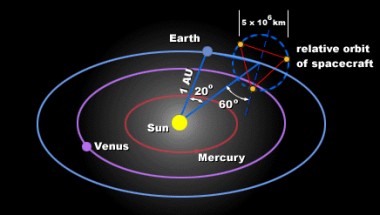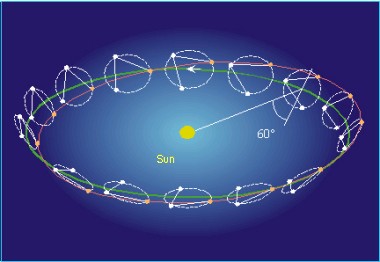Triplets in space
| NOTE: In March 2011 ESA announced a new way forward for the L-class candidate missions: LISA, EJSM-Laplace and IXO. ESA and the scientific community are now studying options for European-only missions that offer a significant reduction of the cost of these missions while maintaining their core science objectives. In the context of this reformulation exercise LISA has become the New Gravitational wave Observatory (NGO). An outline of the steps for the study are given here.
The NGO assessment study report (Yellow Book) is now available. |
According to the current concept, the three identical LISA spacecraft will go into space together on a single launcher. After launch the trio separate and use their ion drives to reach their operational orbits in 13 months. There, they jettison their propulsion modules leaving the attitude and drag-free control to µN thrusters.
The three spacecraft will be located at the apex of a quasi-equilateral triangle, separated from each other by 5 million kilometres. The orbits will be similar to the Earth's, but will trail behind our planet at distances of around 50 million kilometres, equivalent to 20 degrees. The position of the formation 20 degrees behind the Earth is a result of a trade-off between minimising the gravitational disturbances from the Earth-Moon system and the communications needs. While going farther away would further reduce the disturbances, the larger distance would require larger antennas or higher transmitter power.
|
A schematic diagram of the LISA spacecraft in formation as they orbit around the Sun. The spacecraft are separated from each other by 5 million km and trail behind the Earth at a distance of 50 million km (equivalent to 20 degrees). |
The LISA triangle will face the Sun, slanting at 60 degrees to the plane of the Earth's orbit and revolving with the Earth around the Sun (see illustration below). These particular heliocentric orbits for the three spacecraft were chosen such that the triangular formation is maintained throughout the year, with the triangle appearing to rotate about the centre of the formation once per year. The relative movement of the three spacecraft will help to detect the direction of each source, and to reveal the nature of the gravitational waves.
|
A schematic illustration of the orbit carved out by the LISA spacecraft as they revolve with the Earth around the Sun. |
Communication
Each spacecraft carries two 30 cm-diameter steerable high-gain antennas for communication with Earth. Using the 34 m antennas of the Deep Space Network and 5 W transmitter power, data can be transmitted in the X-band at a rate of 7 kbit/s. Data are transmitted for 8 hours every 2 days and stored onboard in a solid-state mass memory of 1 Gb during times of no communication. Only one spacecraft is used to transmit data to Earth; the other two transmit their data to the 'master spacecraft' via the laser link between the three spacecraft. Nevertheless, all three spacecraft are identical which not only reduces cost but also increases redundancy because each could become the master spacecraft.


